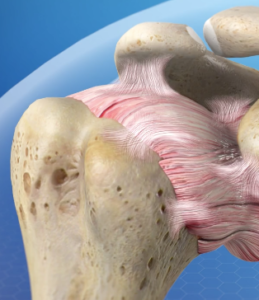Frozen Shoulder Education
Omaha Frozen Shoulder Information by Dr. Darren Keiser
 Frozen shoulder, also called adhesive capsulitis, causes pain and stiffness in the shoulder. Over time, the shoulder becomes very hard to move.
Frozen shoulder, also called adhesive capsulitis, causes pain and stiffness in the shoulder. Over time, the shoulder becomes very hard to move.
Frozen shoulder occurs in about 2% of the general population. It most commonly affects people between the ages of 40 and 60, and occurs in women more often than men.
Your shoulder is a ball-and-socket joint made up of three bones: your upper arm bone (humerus), your shoulder blade (scapula), and your collarbone (clavicle).
The head of the upper arm bone fits into a shallow socket in your shoulder blade. Strong connective tissue, called the shoulder capsule, surrounds the joint.
To help your shoulder move more easily, synovial fluid lubricates the shoulder capsule and the joint.
Description
In frozen shoulder, the shoulder capsule thickens and becomes tight. Stiff bands of tissue — called adhesions — develop. In many cases, there is less synovial fluid in the joint. The hallmark sign of this condition is being unable to move your shoulder – either on your own or with the help of someone else. It develops in three stages:
Freezing
In the”freezing” stage, you slowly have more and more pain. As the pain worsens, your shoulder loses range of motion. Freezing typically lasts from 6 weeks to 9 months.
Frozen
Painful symptoms may actually improve during this stage, but the stiffness remains. During the 4 to 6 months of the “frozen” stage, daily activities may be very difficult.
Thawing
Shoulder motion slowly improves during the “thawing” stage. Complete return to normal or close to normal strength and motion typically takes from 6 months to 2 years.
Cause
The causes of frozen shoulder are not fully understood. There is no clear connection to arm dominance or occupation. A few factors may put you more at risk for developing frozen shoulder.
Diabetes
Frozen shoulder occurs much more often in people with diabetes, affecting 10% to 20% of these individuals. The reason for this is not known.
Other diseases
Some additional medical problems associated with frozen shoulder include hypothyroidism, hyperthyroidism, Parkinson’s disease, and cardiac disease.
Immobilization
Frozen shoulder can develop after a shoulder has been immobilized for a period of time due to surgery, a fracture, or other injury. Having patients move their shoulders soon after injury or surgery is one measure prescribed to prevent frozen shoulder.
Symptoms
Pain from frozen shoulder is usually dull or aching. It is typically worse early in the course of the disease and when you move your arm. The pain is usually located over the outer shoulder area and sometimes the upper arm.
Doctor Examination
After discussing your symptoms and medical history, your doctor will examine your shoulder. Your doctor will move your shoulder carefully in all directions to see if movement is limited and if pain occurs with the motion. The range of motion when someone else moves your shoulder is called “passive range of motion.” Your doctor will compare this to the range of motion you display when you move your shoulder on your own (“active range of motion”). People with frozen shoulder have limited range of motion both actively and passively.
Imaging Tests
Other tests that may help your doctor rule out other causes of stiffness and pain include:
X-rays. Dense structures, such as bone, show up clearly on x-rays. X-rays may show other problems in your shoulder, such as arthritis.
Magnetic resonance imaging (MRI) and ultrasound. These studies can create better images of problems with soft tissues, such as a torn rotator cuff.
Treatment
Frozen shoulder generally gets better over time, although it may take up to 3 years. The focus of treatment is to control pain and restore motion and strength through physical therapy.
Nonsurgical Treatment
More than 90% of patients improve with relatively simple treatments to control pain and restore motion.
Non-steroidal anti-inflammatory medicines
Drugs like aspirin and ibuprofen reduce pain and swelling.
Steroid injections
Cortisone is a powerful anti-inflammatory medicine that is injected directly into your shoulder joint.
Physical therapy
Specific exercises will help restore motion. These may be under the supervision of a physical therapist or via a home program. Therapy includes stretching or range of motion exercises for the shoulder. Sometimes heat is used to help loosen the shoulder up before the stretching exercises.
Frozen Shoulder information provided by Dr. Darren Keiser.
